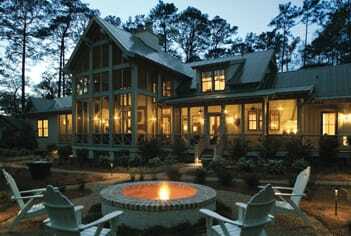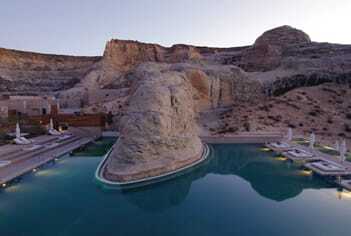The last few years have not been kind to the resort industry. In addition to the credit crisis and plummeting real estate values, high unemployment and lower levels of disposable income have made people less predisposed to travel. Consequently, greenfield resort development in the United States has ground to a virtual halt.
Yet there are glimmers of hope domestically. People are resuming travel. In some spots, such as San Francisco, hotels are trading at prices that are above where they were in 2007. New York City just experienced record hotel occupancy rates this past May. As long as the market did not get overbuilt, hotels are coming back, says Greg Cory, principal of San Francisco–based Land Use Economics LLC and chairman of ULI’s Recreation Development Council. However, areas that got overbuilt, such as Dubai and the coasts of Spain and Portugal, are predicted to take longer to recover.
Since Lehman Brothers went bankrupt in 2008, it has been more difficult to secure commercial credit, which means that financing for resorts has tightened. Private equity funds, claims Cory, have money to invest but find it folly to invest in new-build when they can buy existing property with an income stream for less. In the past few years there has been a raft of well-publicized failures, bankruptcies, and changes in ownership: Tamarack Resort in Idaho is for sale for a fraction of its development cost and Bank of America is currently threatening to dismantle and sell the ski lifts; Moonlight Basin in Montana defaulted on a $100 million loan; and the Base Village at Snowmass in Colorado is in receivership. Suncadia in Washington state just secured refinancing and dodged bankruptcy. The Yellowstone Club in Montana was derailed by sketchy accounting practices, lawsuits, a divorce between the owners, and what were deemed predatory lending practices by Credit Suisse. Just one year after the Hyatt Regency Clearwater Beach Resort and Spa in Florida debuted as a sign of the area’s rebirth, its developers are facing foreclosure on their $141 million mortgage. It is only when occupancies and average daily rates are back up across the board that Cory foresees new development.
| A home at Palmetto Bluff, a resort located in the Carolina Low Country between Charleston, South Carolina, and Savannah, Georgia. |
| Palmetto Bluff cottages with views of the May River. |
| The heated swimming pool at Amangiri, which wraps around a 165 million-year-old rock escarpment. |
The resort industry has been squeezed from all angles. While it makes sense that underemployed and unemployed people tend not to vacation in resorts, at the onset of the recession many groups and individuals with money pulled back as well. The public outrage over AIG executives enjoying the St. Regis Resort in Monarch Beach, California, mere days after getting an $85 billion bailout from the federal government caused many business and convention groups to scale back their own retreats. Only recently have groups started feeling comfortable booking luxury resorts again.
Other resorts failed because they were built in areas where there was not adequate infrastructure or airlift. Many destination clubs were rocked by massive failures because many fees were predicated on real estate appreciation, says Rick Norton, principal of Norton Consulting. Lastly, says Cory, the industry was hurt by a tendency among resort developers to pursue the high end. After all, the world only has so many Russian oligarchs.
Layered on top of this, adds Cory, is a regulatory climate that can make it difficult to build new product—even when economic conditions are favorable. For example, Cory worked with a planned ski area in Colorado where the owner had his permits from the U.S. Forest Service and plans approved in 1981, but the regulatory climate kept changing. Development was held up by lawsuits from an environmental group and eventually the owner abandoned the plans in 1997 after $30 million to $40 million was spent exploring the venture.
“The general overriding premise,” says Scott Berman, industry leader of the hospitality and leisure practice of PricewaterhouseCoopers and a ULI council chair, “is that resorts are high risk, high reward. . . . They’re risky from a development standpoint because they tend to cost more to build. . . . To be in a high-end resort, jet-set community, the land-cost starting point will typically be higher than anywhere else. In many cases, you’re developing in remote and exclusive destinations where the cost of development in terms of importing labor and materials is at its highest.” In addition, the high degree of seasonality of many resorts means that owners have to “make hay in typically very few months.”
However, there is development outside the United States, including Thailand and Vietnam. Noting that South America’s economy has avoided much of the current global downturn, Norton points to Colombia, Brazil, Peru, and Chile as bright spots. There are places ripe for more development that have not been developed for various reasons. For the Galapagos Islands, for instance, the economic benefits of tourism have to be weighed against damage to the fragile ecosystem caused by too many tourists. Mexico, which has thousands of miles of coastline, also has myriad public relations issues, says Norton.
In the United States, says Cory, resorts in locations like Aspen and Vail, Colorado, and Jackson Hole, Wyoming, have fared the best in the current economy because there is an established pattern of people wanting to go there that dovetails with a scarcity of rooms and availability. Secondary and tertiary markets might not have the airlift or the array of experiences that first-tier markets offer, and therefore may take more time to come back. The good news, however, is that the inventory of resorts is still relatively small when benchmarked against overall hotel supply: there are 5 million hotel rooms in the United States, but only half a million of them are in the resort category, says Berman.
Resort owners today include a mix of private equity companies, real estate funds, real estate investment trusts, and high-net-worth individuals. Some of North America’s biggest and newest resorts started out as timberland. Suncadia (developed by Jeld-Wen Windows, Lowe Enterprises, and PacTrust) was initially owned by Plum Creek Timber. Palmetto Bluff in South Carolina was built on land owned by Union Camp (now part of International Paper). The St. Joe Company developed WaterColors and WaterSound in Florida. Some of the biggest management and development companies include Lowe Enterprises, Vail Resorts, and KSL Resorts. Millionaire and former coal company owner Jim Justice bought the Greenbrier in White Sulphur Springs, West Virginia, out of bankruptcy. Companies like Hyatt and Marriott that often brand and lend credibility to a resort have trended away from ownership and are focusing more on operations, says Cory.
Fractional ownership, destination clubs, and timeshares are key pieces of the resort experience. However, potential purchasers of wholly owned or fractional property within a resort often find they cannot obtain financing. This limits the market in many cases to people who can pay cash—and who just might be enticed by the current oversupply of inventory in the second-home market selling for bargain prices.
Furthermore, demographics are working against resort owners who hope to generate new sales. “The supposition,” says Cory, “is that 90 percent of the baby boomers who are going to make a decision on second homes have already done so—and many of those baby boomers will be ready to divest of those properties in the next five to ten years.” The next population group, generation X, is about 70 percent the size of the baby boomer cohort.
But there are advantages for consumers who choose to buy property within a resort, says Cory. Studies indicate that comparisons of similar real estate inside and outside the resort gates show a measurable benefit to being inside the gates, ranging from 10 percent to up to 50 percent more in value if the asset is in a premium location, such as on a golf course. People who buy into resorts are “really buying the ambience, sense of community, and identity as part of that purchase decision,” he says. But, when some resorts charge $20,000 to $30,000 in annual associated fees, it is causing potential buyers to whip out their calculators and take a hard look at what their total ownership costs will be.
The inability of credit markets to work correctly after Lehman Brothers failed forced the timeshare and fractional industry’s sales to slow, “not because people weren’t willing to buy our product, but because we had no financing to offer those consumers,” says Howard Nusbaum, president of the Washington, D.C.–based American Resort Development Association. In the early 2000s, thanks to easy credit and low interest rates, it “became very compelling for a resort owner to play banker and not worry so much about the efficiency of the sale of the resort because they were going to make a boatload of money on the arbitrage of the loan . . . [and on] managing the project,” he says.
Three years ago, timeshares were a $10.6 billion industry; today, they are a $6 billion industry with more inventory. The silver lining, Nusbaum believes, is that the fundamentals of the business have improved. Potential buyers have their credit ratings scored and have to put down 20 percent instead of 10. Furthermore, the industry has moved away from sales and marketing lead-generation programs that were costing 60 cents on the dollar.
The downturn has created “inventory absorption opportunity,” says Nusbaum, not only of existing timeshare inventory, but also of wholly owned condominium projects that could be converted into timeshares. Southeast Florida and Las Vegas are ripe for these types of opportunities. The abundance of wholly owned condos for sale means there has not been much reason to build new timeshare product since 2008, although Disney, Starwood, and Hilton have all recently lent their name to new resorts in Hawaii (Disney’s Aulani just opened this August). One timeshare project that was on the books and compelling enough to continue work on was Wyndham Vacation Resort’s National Harbor outside Washington, D.C. Next year, Nusbaum predicts that the industry might start seeing some new growth as the credit markets come back and inventory draws down.
Key resort amenities include golf, skiing, and some sort of water feature, whether it be a beach or a pool. Spas have become much more popular, says Cory, and they are getting bigger, with spas of 20,000 and 30,000 square feet (1,900 to 2,800 sq m) not unheard of. Family-themed resorts are offering Wii rooms, which are an inexpensive but popular amenity for kids, as are kids’ camps. Many properties do programming to round out occupancy and generate traffic during the off-season such as bringing in celebrity chefs or creating themed weeks.
When it comes to amenities at resorts today, mixed use is becoming the norm, says Nusbaum. “It’s very common to see the golf course, tennis, pools, and spa being shared by hotel guests, fractional [owners], and timeshare owners, and maybe even by wholly owned owners in a resort environment.” Mixed use gives resorts the ability to turn on and off different markets depending on what is going on in the economy. Mixed use also enables smaller resorts to provide more amenities. There are even examples of mixed use within a building: Hilton Hotels, for example, turned two floors of the Hilton New York into timeshare units.
Berman notes that resort developers are minimizing their risks by relying on multiple business models instead of just the traditional hotel resort model.
Ultimately, he notes, “You develop a resort environment for one of two reasons: one, to make money, or two, to satisfy your ego. If it’s the second, fine, but make sure that you know you will be subsidizing that property for years to come.” He has advised many clients thinking about resort development to pass. “Only 10 percent of the projects that are papered ever turn on a light. It takes developers with deep pockets, stamina, and courage. It’s a difficult business that needs to be analyzed and studied carefully.” Cory adds, “The main thing that the whole community needs to remember is that nobody needs this class. It’s not housing, it’s not a place to work, it’s not bricks and mortar you might need for retailing. It’s purely discretionary spending.”






